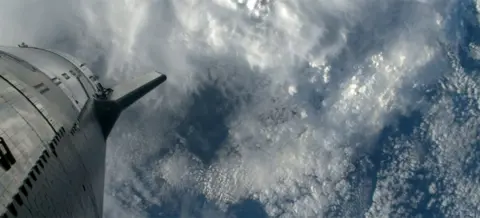SpaceX launches Starship for the third time.
The two-stage vehicle produced a clean getaway from its Texas launch site, to send its upper portion around the globe to a re-entry over the Indian Ocean.
Radio contact was lost towards the end but the firm said it was “incredible to see how far we got this time around”.
SpaceX boss Elon Musk was delighted with the outcome of the flight, too.
He posted on X, formerly Twitter, that “Starship will take humanity to Mars”.
When the 120m-tall (395ft) vehicle launched in April and November last year, it blew apart not long into the missions.
Mr Musk was looking for significant improvement from his SpaceX team this time – and he got it.
The rocket left its launch mount with a huge rumble from its 33 engines, and the vehicle then proceeded to step perfectly through all of the anticipated phases in the climb to space.
Separation of the bottom half, the booster, from the top half, the Ship, occurred right on cue, two minutes and 44 seconds into the flight.
The ship then powered on, crossing the Atlantic and southern Africa.
Video cameras sent back spectacular views of Earth from more than 100 miles up.

Then came the task of re-entry, when the ship needed to descend to a splashdown in the ocean.
Video imagery once again captured incredible scenes as hot gases enveloped the vehicle, just before radio contact was interrupted.
Controllers reported shortly after that the Ship had been “lost”, presumably because it had broken up.

Not every milestone was ticked off. It was hoped the booster after separation might have been able to power its way back to a controlled drop into the sea just off the Texas coast. It got close but it looked as though the vehicle came in way too fast and was lost before hitting the water.
The Ship, too, was expected to re-ignite an engine to initiate the re-entry, but this was skipped for a reason not immediately apparent.
READ MORE Video, photos
